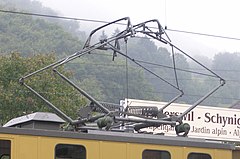Pantograph (transport)

A pantograph for rail lines is a hinged electric-rod device that collects electric current from overhead lines for electric trains or trams. The pantograph typically connects to a one-wire line, with the track acting as the ground wire. The term stems from the resemblance to pantograph lever-rod devices for copying handwriting and drawings.
Invention

A flat slide-pantograph was invented in 1895 at the Baltimore & Ohio Railroad[1] and in Germany in 1900 by Siemens & Halske. The familiar diamond-shaped roller pantograph was invented by John Q. Brown of the Key System shops for their commuter trains which ran between San Francisco and the East Bay section of the San Francisco Bay Area in California.[2][3] They appear in photographs of the first day of service, 26 October 1903.[4] For many decades thereafter, the same diamond shape was used by electric-rail systems around the world and remains in use by some today.
The pantograph was an improvement on the simple trolley pole, which prevailed up to that time, primarily because it allowed an electric-rail vehicle to travel at higher speeds without losing contact with the catenary.
Modern use


Template:J of pantograph today is the so called half-pantograph (sometimes 'Z'-shaped), which has evolved to provide a more compact and responsive single-arm design at high speeds as trains get faster. The half-pantograph can be seen in use on everything from very fast trains (such as the TGV) to low-speed urban tram systems. The design operates with equal efficiency in either direction of motion, as demonstrated by the Swiss and Austrian railways whose newest high performance locomotives, the Re 460 and Taurus respectively, operate with them set in opposite directions.
Technical details

Template:J for modern electric rail systems consists of an upper weight carrying wire (known as a catenary) from which is suspended a contact wire. The pantograph is spring-loaded and pushes a contact shoe up against the contact wire to draw the electricity needed to run the train. The steel rails on the tracks act as the electrical return. As the train moves, the contact shoe slides along the wire and can set up acoustical standing waves in the wires which break the contact and degrade current collection. This means that on some systems adjacent pantographs are not permitted.
Pantographs are the successor technology to trolley poles, which were widely used on early streetcar systems. Trolley pole are still used by trolleybuses, whose freedom of movement and need for a two-wire circuit makes pantographs impractical, and some streetcar networks, such as the Toronto Streetcar System, which have frequent turns sharp enough to require additional freedom of movement in their current collection to ensure unbroken contact.
Pantographs with overhead wires are now the dominant form of current collection for modern electric trains because, although more expensive and fragile than a third-rail system, they allow the use of higher voltages.
Pantographs are typically operated by compressed air from the vehicle's braking system, either to raise the unit and hold it against the conductor or, when springs are used to effect the extension, to lower it. As a precaution against loss of pressure in the second case, the arm is held in the down position by a catch. For high-voltage systems, the same air supply is used to "blow out" the electric arc when roof-mounted circuit breakers are used.[5][6]
Single- and double-arm pantographs

Pantographs may have either a single or a double arm. Double-arm pantographs are usually heavier, requiring more power to raise and lower, but may also be more fault-tolerant.
On railways of the former USSR, the most widely-used pantographs are those with a double arm ("made of two rhombs"), but since the late 1990s there have been some single-arm pantographs on Russian railways. Some streetcars use double-arm pantographs, among them the Russian KTM-5, KTM-8, LVS-86 and many other Russian-made trams, as well as some Euro-PCC trams in Belgium. American streetcars use either trolley poles or single-arm pantographs.
Metro systems and overhead lines

Most rapid transit systems are powered by a third rail, but some use pantographs, particularly ones that involve extensive above-ground running. Hybrid metro-tram or 'pre-metro' lines whose routes include tracks on city streets or in other publicly-accessible areas, such as the MBTA Green Line, must of course use overhead wire, since a third rail would normally present too great a risk of electrocution.
One exception to this is the new Bordeaux tram system that uses an underground system called alimentation par sol, which only applies power to segments of track that are completely covered by the tram. This system is used in the historic centre of Bordeaux where an overhead wire system would cause a visual intrusion.
Overhead pantographs are sometimes used as alternatives to third rails because third rails can ice over in certain winter weather conditions. The MBTA Blue Line or the Wonderland Line uses pantograph power for all of its surface route. The entire Metro systems of Barcelona, Shanghai, Hong Kong, and Seoul use overhead wiring and pantographs.
Until 2010 the Oslo metro line 1 changed from third rail to overhead line power at Frøen station. Due to the many level crossings, it was deemed difficult to install a third rail on the rest of the older line 1 tracks.[7]
See also
References
- ^ "A ninety-six ton electric locomotive". Scientific American. New York. 10 August 1895.
- ^ U.S. Patent No. 764224 issued July 5, 1904
- ^ Key System Streetcars, by Vernon Sappers, Signature Press 2007, p.369.
- ^ The Key System: San Francisco and the Eastshore Empire, by Walter Rice and Emiliano Echeverria, Arcadia Publishing 2007, photos, pages 13, 16.
- ^ Hammond, Rolt (1968). "Development of electric traction". Modern Methods of Railway Operation. London: Frederick Muller. pp. 71–73. OCLC 467723.
- ^ Ransome-Wallis, Patrick (1959). "Electric motive power". Illustrated Encyclopedia of World Railway Locomotives. London: Hutchinson. p. 173. ISBN 0-486-41247-4. OCLC 2683266.
- ^ http://www.youtube.com/watch?v=WYleLB87g_o&NR=1
